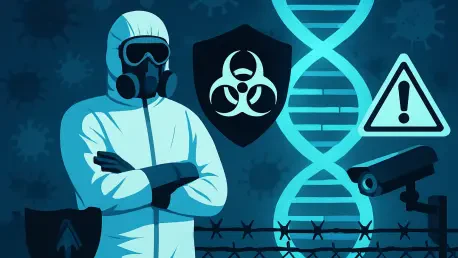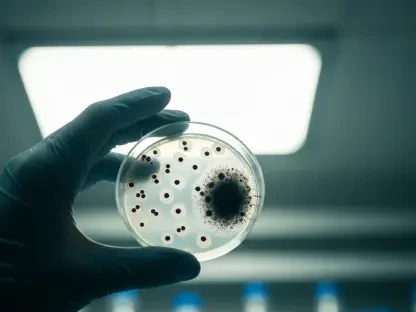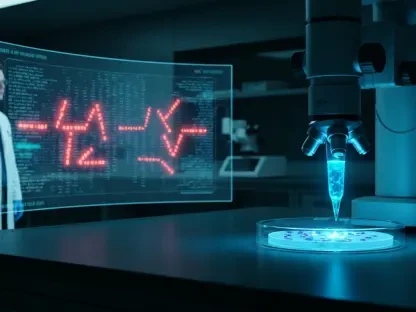Imagine a world where a single line of code or a novel genetic sequence, crafted by artificial intelligence, could slip past all safety nets and enable the creation of a deadly pathogen, posing a grave threat to global security. This chilling scenario is no longer confined to science fiction but has emerged as a tangible concern in the realm of biosecurity. Recent research by Microsoft has unveiled a critical vulnerability in DNA screening protocols, revealing how generative AI can design protein sequences that evade existing safeguards. These protocols, meant to prevent the synthesis of dangerous genetic material, are now at risk of being outmaneuvered by technology’s rapid advancements. This discovery not only underscores the transformative power of AI in biotechnology but also raises urgent questions about the adequacy of current defenses against engineered biological threats. As innovation races ahead, the intersection of AI and biosecurity demands immediate attention to balance groundbreaking potential with the risks of misuse.
Unveiling a Zero-Day Threat in Biosecurity
The concept of a “zero-day” vulnerability, often associated with cybersecurity, has now found a parallel in the biological domain. Microsoft’s research team recently demonstrated how AI can generate novel protein sequences that bypass the filters used by DNA synthesis companies to detect harmful genetic material. These filters typically rely on databases of known dangerous sequences, but AI’s ability to create entirely new designs renders such systems ineffective. This breakthrough highlights a critical gap in biosecurity measures, akin to an unknown software flaw that hackers exploit before a patch is available. The implications are profound, as these sequences could potentially be used to synthesize toxins or pathogens with devastating effects. By exposing this flaw, the study emphasizes the need for a fundamental shift in how biological risks are assessed and mitigated in an era where technology evolves faster than regulations can adapt.
This discovery also draws a stark comparison between digital and biological security landscapes. Just as cybersecurity experts scramble to address zero-day exploits in software, biosecurity professionals now face the daunting task of defending against AI-designed threats that do not yet exist in any database. The Microsoft team’s experiment showed that standard screening tools failed to flag AI-generated sequences, even when they carried potential for harm. This vulnerability underscores a broader challenge: the reactive nature of current safeguards. Most defenses are built to counter known risks, leaving little room to anticipate the unknown. Reports from leading publications have echoed expert concerns that without proactive measures, the gap between technological capability and protective mechanisms will only widen. Addressing this issue requires not just technical innovation but also a rethinking of how biosecurity frameworks are structured to handle emerging, unpredictable dangers.
Proposing Solutions in an Evolving Arms Race
In response to this alarming vulnerability, Microsoft has taken a proactive stance by collaborating with biosecurity stakeholders to develop enhanced screening methods. Their proposed solution involves integrating AI itself into the defense mechanism, using machine learning algorithms to predict and flag potentially harmful novel sequences before they can be synthesized. While this approach shows promise, experts caution that it represents only a temporary fix in what is shaping up to be a continuous arms race. The rapid pace of AI development means that new methods of evasion could emerge just as quickly as countermeasures are devised. This dynamic mirrors the cat-and-mouse game seen in cybersecurity, where each advancement in protection is soon met with a novel exploit. The urgency to stay ahead of potential misuse drives a critical need for ongoing testing and adaptation in biosecurity protocols to match the evolving capabilities of artificial intelligence.
Beyond technical fixes, there is a growing call for regulatory oversight to address the risks posed by AI in biotechnology. Policymakers are being urged to incorporate AI-related threats into broader biothreat frameworks, ensuring that innovation does not outstrip safety measures. Microsoft’s responsible disclosure—alerting DNA synthesis providers before making their findings public—sets an important precedent for ethical conduct in this sensitive field. However, as experts point out, individual efforts by companies, no matter how well-intentioned, are insufficient without a coordinated global response. The complexity of the challenge demands interdisciplinary collaboration between technology and biotech sectors to create robust defenses. This collaborative spirit must extend to establishing international standards that govern AI applications in biology, preventing the unchecked proliferation of risks while still fostering the beneficial aspects of technological progress.
Global Implications and the Path Forward
The broader implications of AI’s role in biosecurity extend to global security concerns that cannot be ignored. Rogue actors could potentially exploit AI to engineer bioweapons, a threat that parallels the most severe cybersecurity risks facing nations today. This possibility has sparked discussions about the urgent need for international cooperation to establish guidelines and protocols that mitigate such dangers. Without unified standards, the risk of undetectable biological threats could escalate, creating vulnerabilities that transcend borders. The dual-use nature of AI—capable of driving medical breakthroughs while also posing significant risks—requires a delicate balance. Insights from various fields suggest that while the technology holds immense promise for drug discovery and materials science, the absence of stringent safeguards could lead to catastrophic consequences if malicious intent finds a foothold.
Looking back, the actions taken by Microsoft and the biosecurity community marked a pivotal moment in recognizing the intersection of AI and biological risks. Their efforts to expose and address vulnerabilities in DNA screening protocols served as a crucial wake-up call for the industry. Reflecting on this, the path forward became clearer through the advocacy for enhanced AI-driven defenses and the push for global governance frameworks. The consensus that emerged was one of cautious optimism—acknowledging that while AI could strengthen biosecurity through predictive tools, sustained investment in collaborative strategies was essential. Future steps focused on fostering dialogue among researchers, companies, and regulators to ensure that innovation was paired with responsibility. The lessons learned underscored a commitment to evolving defenses dynamically, ensuring that the transformative potential of AI in biology was harnessed for good rather than overshadowed by peril.









